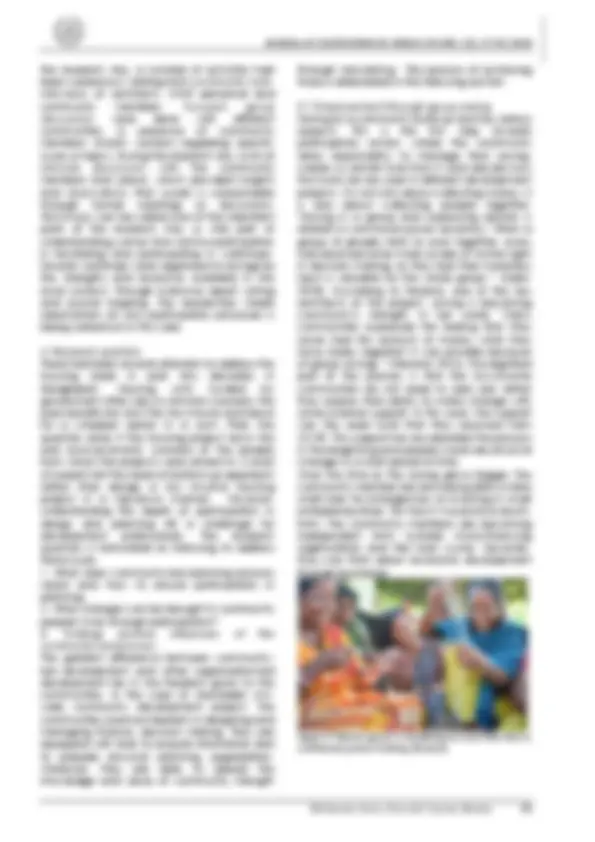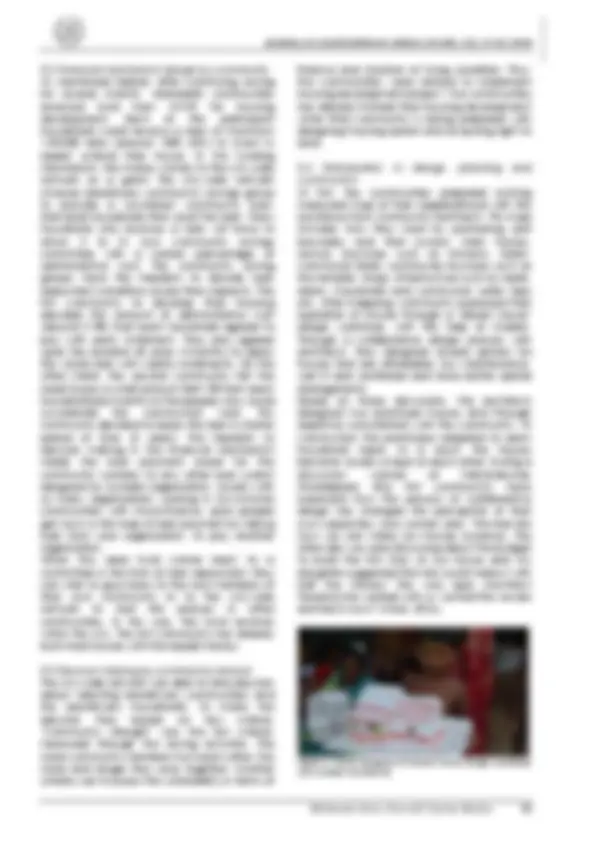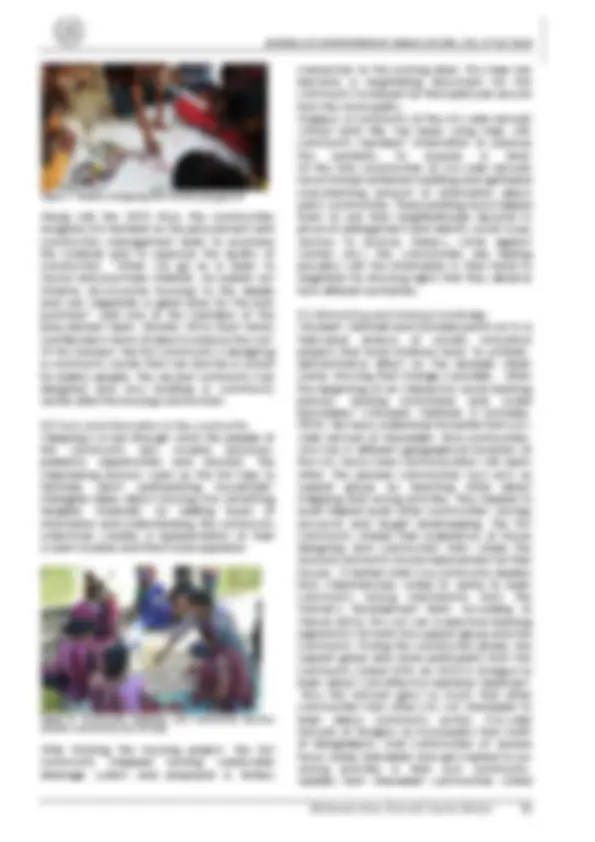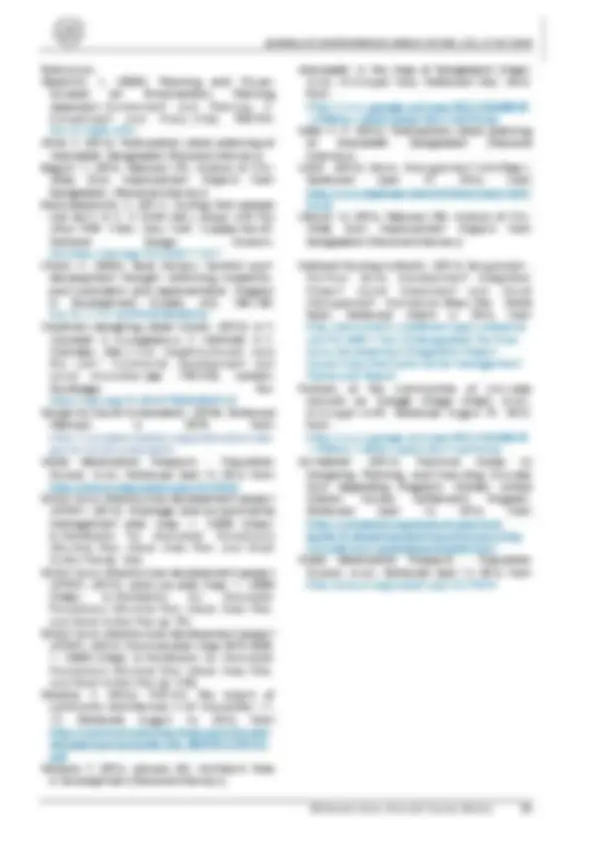






Study with the several resources on Docsity

Earn points by helping other students or get them with a premium plan


Prepare for your exams
Study with the several resources on Docsity

Earn points to download
Earn points by helping other students or get them with a premium plan
Community
Ask the community for help and clear up your study doubts
Discover the best universities in your country according to Docsity users
Free resources
Download our free guides on studying techniques, anxiety management strategies, and thesis advice from Docsity tutors
Empowering The Urban Poor Through Participatory Planning Process: A Case From Jhenaidah, Bangladesh
Typology: Essays (university)
1 / 8

This page cannot be seen from the preview
Don't miss anything!





2019, Volume 3, Number 2 , pages 47 – 54
1 & 2 (^) Community architect, Platform of Community Action and Architecture, Bangladesh Email: aritra.ahmed@gmail.com Email: emerald.upoma@gmail.com
Doi:10.25034/ijcua.2018. 4700 www.ijcua.com Copyright © 2018 Contemporary Urban Affairs. All rights reserved.
1. Introduction Urbanization in Bangladesh is moving at a rapid pace. Between 1961 to 1981, the average urban growth rate was 8%. The present average growth rate is about 4.5%. According to the population census of 2001, the share of urban population was about 23.29% and at present it is approximately 37%. The importance of urban development is emphasized in terms of its role in the national economy. More than 60% of the national GDP is derived from the non- agricultural sectors that are mainly based in urban areas. The expansion of urban economy leads to the growth of urban population and concomitant haphazard urban spatial growth without planning. (District town infrastructure development project (DTIDP, 2015) The case study is from a city corporation in the western part of Bangladesh, named ‘Jhenaidah’. Jhenaidah is a medium sized municipality of Bangladesh. Jhenaidah Municipality stands on the bank of the Noboganga River. Located on 210 km west to the capital city(Dhaka) Bangladesh. Jhenaidah Municipality was established in 1958. This is a class “A” municipality. The municipality consists of 9 wards and 33 mahallas (neighborhoods). * Corresponding Authors: Community architect, Platform of Community Action and Architecture, Bangladesh E-mail address: aritra.ahmed@gmail.com
Article history: Received 09 February 2018 Accepted 15 May 201 8 Available online 26 September 2018 Keywords: Sustainable planning; Community- led ; Development process; Socio-economic Sustainability; Socio-politic dynamics; This work is licensed under a Creative Commons Attribution
The national focus on economic development has taken Bangladesh a long way, even with some complex problems (overpopulation or natural hazards). In a short period of time, Bangladesh is on the verge of becoming ‘middle income country’ from ‘developing country’. The economic development of the cities is driving people to come to the city for work, and Jhenaidah is no exception. So, when new people are coming to the city everyday, the need of housing is increasing. Figure 1 : Jhinaidah, on the map of Bangladesh (Google map, 2016)
2. Background of the community-led development project Initially, five low-income communities had formed a city-wide network. Currently, this network has 9 communities as members and few more as interested. The basis of creating the network was to start saving group within community. The member communities have been saving since 2015. After the communities started saving, they were eligible to apply for a seed fund from ACHR (Asian Coalition for Housing Rights). ACHR usually gives two kinds of fund for city-wide development; fund for building houses and for small infrastructure upgrading, such as waste management, drainage or community space making. City- wide network at Jhenaidah has received funding from ACHR for two consecutive years. The idea is to include this as seed fund in a revolving loan system. Two beneficiary communities have developed housing with this fund and they will be repaying to city-wide network. Then the next communities in pipeline will receive the fund. The network aims to expand the fund from their own savings along with the external funds. Since 2015, the communities of Jhenaidah have built 45 houses in total. In the first year (2015-2016), Mohishakundu community built 20 houses. In the second year the same community built 8 more houses. In the second year (20116-2017), Vennatola community built 18 houses. Figure 2: Geographical locations of communities of the city- wide The city-wide network has received assistance from Co-creation Architects, Platform of Community Action And Architecture (POCAA) and NGO Alive. The initiative also received advice from Jhenaidah municipality, department of Architecture of Brac University, Polytechnic institute of Jhenaidah, Jhenaidah chambers of commerce etc. Figure 3: the previous and present condition of housing Co-creation Architects is an architectural firm, which provides services to both low-income and middle- income group of people. POCAA is a platform for group of architects who introduce themselves as ‘community architect’. POCAA began its journey with an intention to work for disadvantaged communities (though not limited) by housing and community development. Alive is a local NGO, active in Jhenaidah and some other cities of Bangladesh. They have collaborated with POCAA for housing development project. They are responsible for mobilizing, skill developing and construction supervision in all communities. Figure 4: City-wide network and support groups 3. Methodology The paper has taken qualitative approach for the research. The researchers had spent several months in Jhenaidah as ‘research stay’. During
5.2 Financial mechanism design by community As mentioned before, after continuing saving for several months, Jhenaidah communities received fund from ACHR for housing development. Each of the participant households could receive a loan of maximum 1,00,000 taka (around 1300 USD) to invest in repair/ extend their house. In this funding mechanism, the money comes to the city-wide network as a grant, the city-wide network chooses beneficiary community savings group to provide a no-interest community loan. Individual households then avail the loan. Every household who receives a loan will have to return it to its own community savings committee with a certain percentage of administrative cost. The community saving groups have the freedom to decide loan repayment conditions as per their capacity. The first community to develop their housing decided the amount of administrative cost (around 2.4%) that each household agreed to pay with each instalment. They also agreed upon the duration (8 years 4 months) to repay the whole loan with weekly instalments. On the other hand, the second community felt the need to pay a small amount (Bdt 100 from each household per month) to the people who would co-ordinate the construction work. This community decided to repay the loan in shorter period of time (5 years). The freedom to decision making in the financial mechanism made the loan payment easier for the community contrary to any other loan system designed by outsider organisation. Usually with so many organisations working in low-income communities with micro-finance, poor people get stuck in the loop of loan payment by taking loan from one organisation, to pay another organisation. When the seed fund comes back to a committee in the form of loan repayment, they can start to give loans to the next members of their own community or to the city-wide network to start the process in other communities. In this way, the fund revolves within the city. The first community has already built more houses with the repaid money. 5.3 Decision making by community network The city-wide network was able to take decision about selecting beneficiary communities and the beneficiary households. To make the decision they based on few criteria. ‘Community strength’ was the first criteria, measured through the saving activities. The more community members trust each other, the more and longer they save together. Another criteria was to assess the vulnerability in terms of finance and situation of living condition. Thus, the communities were ranked to implement housing development project. Two communities has already finished their housing development while third community is being prepared with designing housing option and acquiring right to land. 5.4 Participation in design, planning and construction At first, the communities prepared existing measured map of their neighborhood with the assistance from community architects. This map includes how they lived by positioning plot boundary and their owners, main houses, service structures such as kitchens, toilets, communal toilets, communal structures such as the temples, shops, infrastructure such as roads, drains, household and communal water taps etc. After mapping, community expressed their aspiration of houses through a ‘dream house’ design workshop, with the help of models. Through a collaborative design process with architects, they designed several options for houses that are affordable, low maintenance, well lit and ventilated and have better spatial arrangements. Based on these discussions, the architects designed two prototype houses and through repetitive consultations with the community. At construction the prototypes adapted to each household need. As a result, the houses became visually unique to each other. During a discussion, women at Mohishakundu Shordarpara (the first community) have expressed how the process of collaborative design has changed the perception of their own capacities, one woman said: “We feel like now we can make our houses ourselves. The other day we were discussing about the budget to build the first story of our house and my daughter suggested that she could make it with half the money! The way apa (Architect Farzana) has worked with us, we feel like we are architects now!” (Mina, 2016). Figure 6: House designed at dream house design workshop (Co.creation architects)
Figure 7: Children designing their desired playground Along with the NGO Alive, the communities assigned 2/3 members as the procurement and construction management team to purchase the material and to supervise the quality of construction. ‘‘When we go as a team to source and purchase material, we explain our initiative (low-income housing) to the dealer and can negotiate a great prize for the bulk purchase’’ said one of the members of the procurement team. (Shorifa, 2016) Each family contributed in terms of labor to reduce the cost. At this moment, the first community is designing a community center that can also be a school for elderly people. The second community has designed and now building a community center after the housing constructions. 5.5 Tools and information to the community Mapping is a tool through which the people of the community (ies) visualize resources, problems, opportunities and solutions. The mapmaking process works as the first step to translate each participating households’ intangible ideas about housing into something tangible. Gradually, by adding layers of information and understanding, the community collectively creates a representation of their current situation and their future aspiration. Figure 8: Community mapping, one community teaches another community how to map After finishing the housing project, the first community mapped existing wastewater drainage system and proposed a tertiary connection to the existing drain. This map has become a negotiating document for the community to request for that particular service from the municipality. Arappur, a community of the city-wide network without land title, has been using map with community members’ information to exercise the possibility to acquire a land. All the nine communities of city-wide network have finished settlement profiling and gathered overwhelming amount of information about each communities. These profiling have helped them to see their neighborhoods beyond its physical arrangement and identify social issues (access to services, literacy, crime against women etc.) The communities are feeling powerful with the information in their hand to negotiate for ensuring rights that they deserve from different authorities. 5.6 Networking and sharing knowledge Moulaert, Martinelli and Gonzalez points out in a transversal analysis of socially innovative projects that local initiatives have “a symbolic, demonstrative effect on the broader urban scene, showing that change is possible… often the beginning of an interactive social learning process, blurring institutional and scalar boundaries” (Moulaert, Martinelli, & Gonzalez, 2010). We have understood this better from city- wide network of Jhenaidah. Nine communities, who live in different geographical locations of the city, have close communication with each other. The pioneer communities now acts as support group, by teaching other about mapping and saving activities. They helped to audit helped audit other communities’ savings accounts and taught bookkeeping. The first community shared their experience of house designing and construction from where the second community found improvement for their houses. It started when two community leaders from Mohishakundu visited Sri Lanka to learn community saving mechanisms from the Women’s Development Bank. According to Masud (2016), this visit was a practical learning opportunity for both the support group and the community. During the construction phase, the support group and some participants from the community visited SAFE, an NGO in Dinajpur to learn about cost-effective bamboo treatment. Now the network grew so much that other communities from other city visit Jhenaidah to learn about community action. City-wide network of Dinajpur (a municipality from north of Bangladesh), rural communities of Jessore have visited Jhenaidah and got inspired to run saving activities in their own community. Leaders from Jhenaidah communities visited
They have demonstrated excellent capability in physical and social mapping, facilitating design and construction of houses, and managing saving accounts. The process has been a successful tool in breaking the stubborn barrier of gender inequality, even if in a slow pace and at a small scale. Since 2015, a great change can be noticed in behavior of the women, from being scared to speak at all in front of any male presence (then) to proudly present themselves as ‘community leaders’ to outside visitors (now). This shift was not easy as the male community leaders felt uncomfortable in transferring leadership in the beginning, as if that would mean letting go of their sense of control. When the male leader of Mohishakundu was asked to transfer leadership after an instance of mishandling community savings account, he was openly skeptical about leaving responsibility to women, suggesting that women alone are not capable in managing leadership responsibilities (Masud, 2016).
6. Drawbacks found through the research Jhenaidah city-wide community upgrading process still needs to find solutions to some complex problems. The process had been encouraging for them since there was a money flow from ACHR to realize their dreams. Now that the network needs more time to accumulate money from the repayment of loan, will the communities be able to keep patience and accept the slow process? Even after a long process of mobilizing and building (housing or infrastructure) with a community, it may fall victim of self-sabotaging patterns, sometimes fail to see the bigger picture or become too cautious out of self-interests and lose faith in cohesiveness. Boonyabacha from ACHR says, “There is a notion going around that the poor are helpless, lazy, ignorant, and untrustworthy that they do not have resources or ideas, and that they cannot think for themselves or manage money. So it follows that they need to be helped, trained, organized, spoken for and made aware. This assumption infects the policies of a great deal of the world’s development agencies and of housing-activism, shelter- delivery, and poverty-reduction programs, where solutions are conceived and carried out on the poor’s behalf by professionals, bureaucrats, activists and social organizers." (Boonyabancha, 2017). The support group shares this same value. So for them, the leaders from the first few communities should come forward in the process while the support team gradually steps back. This has not fully happened yet in Jhenaidah. Presence of an external support group has been always needed for the communities in staying focused on collective development efforts. This issue calls for another necessary step to take- setting up a separate community fund and creating a program for capacity building. Boonyabancha from ACHR warns in this regard that, “If a community cannot manage money, it is doomed forever to having its development process determined by someone else” (Boonyabancha, cited Skinner, 2014). In the case of Jhenaidah, the Mayor has always been supporting citizens and local organizations with logistic and legal help in their efforts in city-wide upgrading of disadvantaged communities. But the upgrading process in Jhenaidah needs more technical support from within the municipality. The slum development programs launched by the municipality must coincide the city-wide upgrading process. The dimension of support that Jhenaidah mayor has offered to the upgrading process does not necessarily reflect the status of other municipalities in Bangladesh. The readiness of local government to support disadvantaged communities is a crucial issue but if local government itself is not empowered enough through decentralization, devolution etc., it cannot do much to help the urban poor in the right scale. 7. Conclusion Though focused on housing development, this project or to be more accurate, this process has tapped into the potential of communities to establish institutional associations and to utilize those to bring positive changes in their lives. To answer the question of the research, participation needs to engage user group in such manner, which tells that the development organization or professionals trust in people’s capacity. Despite manifold concerns felt by relevant professionals related to this process, City-wide Community Upgrading process in Jhenaidah is a successful beginning to people- centred planning/ community-driven development. Once the people fully realise the potential and benefits of this process, they will begin to invest more to the process, not only financially, but also their time and agency. Through more decentralized proposals from the grassroots’ levels, the communities can push for participatory budgeting and come out of established institutional frameworks for a better, sustainable future.
References Albrechts, L. (2003). Planning and Power: Towards an Emancipatory Planning Approach. Environment and Planning C: Government and Policy, 21 (6), 905 - 924. Doi:10.1068/c29m Aktar, S. (2016). Participatory urban planning at Jhenaidah, Bangladesh [Personal interview]. Begum, T. (2016, February 29). Analysis of City- Wide Slum Improvement Projects from Bangladesh [Personal interview]. Boonyabancha, S. (2011). Trusting that people can do it. In C. E. Smith (Ed.), Design with the other 90%: Cities. New York: Cooper-Hewitt, National Design Museum. Doi:https://doi.org/10.22269/ Chant, S. (2004). Book Review: Feminist post- development thought: rethinking modernity, post-colonialism and representation. Progress in Development Studies, 4(2), 183 – 185. Doi:10.1177/ Creatively designing urban futures. (2013). In F. Moulaert, E. Swyngedouw, F. Martinelli, & S. Gonzalez (Eds.), Can neighbourhoods save the city?: Community development and social innovation (pp. 198 - 218). London: Routledge. Doi: https://doi.org/10.4324/ Design for Social Sustainability. (2018). Retrieved February 6, 2018, from https://youngfoundation.org/publications/des ign-for-social-sustainability World Urbanization Prospects - Population Division. (n.d.). Retrieved April 14, 2015, from http://esa.un.org/unpd/wup/CD-ROM/ District town infrastructure development project (DTIDP). (2013). Drainage and environmental management plan map, 1: 15000 [Map]. In Masterplan for Jhenaidah Paurashava Structure Plan, Urban Area Plan, and Ward Action Plan (p. 166). District town infrastructure development project (DTIDP). (2013). Land use plan map, 1: 15000 [Map]. In Masterplan for Jhenaidah Paurashava Structure Plan, Urban Area Plan, and Ward Action Plan (p. 92). District town infrastructure development project (DTIDP). (2013). Structure plan map 2010-2030, 1: 15000 [Map]. In Masterplan for Jhenaidah Paurashava Structure Plan, Urban Area Plan, and Ward Action Plan (p. 218). Farzana, S. (2016). POCAA: The insects of community architecture. CAN Newsletter , 11-